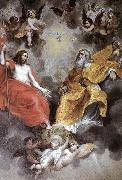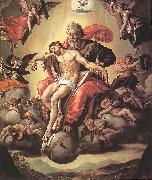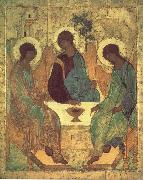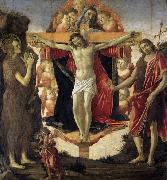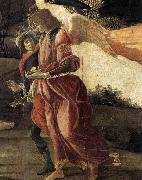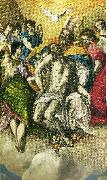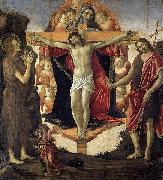Wholesale Oil Painting No Minimum |
|||||||||||
|
|
|||||||||||

|
|||||||||||
|
|
|
||||||||
BALEN, Hendrick vanDutch Baroque Era Painter, ca.1575-1632 Hendrik van Balen (1575 - 1632) was a Flemish painter, who was born and died in Antwerp. Van Balen studied art while traveling in Italy. He was the teacher of Anthony Van Dyck and Frans Snyders and was also a contemporary of many of the other famous Flemish artists, such as the Brueghels, Jan and Peter. |
||||||||
|
|
||||||||
Holy Trinity
Holy Trinity Painting ID:: 4928 |
1620s
Oil on panel
Sint-Jacobskerk, Antwerp 1620s Oil on panel Sint-Jacobskerk, Antwerp |
|||||||
|
|
||||||||
COECKE VAN AELST, PieterFlemish Northern Renaissance Painter, ca.1502-1550 South Netherlandish painter, architect, and linguist. After extensive travels he settled in Antwerp, where he published (1539) a Flemish translation of Vitru-vius's De Architectura and (1539?C53) Serlio's multi-volume treatise into Flemish, French, and High German. |
||||||||
|
|
||||||||
|
|
Holy Trinity
Holy Trinity Painting ID:: 32288 |
Oil on panel,
98 x 84 cm Oil on panel, 98 x 84 cm |
||||||
|
|
||||||||
|
|
||||||||
|
|
Holy Trinity
Holy Trinity Painting ID:: 38395 |
c. 1450
Wood, 64,5 x 54,5 cm
Hungarian National Gallery, Budapest c. 1450 Wood, 64,5 x 54,5 cm Hungarian National Gallery, Budapest |
||||||
|
|
||||||||
MASACCIOItalian Early Renaissance Painter, 1401-1428 was the first great painter of the Quattrocento period of the Italian Renaissance. His frescoes are the earliest monuments of Humanism, and introduce a plasticity previously unseen in figure painting. The name Masaccio is a humorous version of Tommaso, meaning "big", "fat", "clumsy" or "messy" Tom. The name was created to distinguish him from his principal collaborator, also called Tommaso, who came to be known as Masolino ("little/delicate Tom"). Despite his brief career, he had a profound influence on other artists. He was one of the first to use scientific perspective in his painting, employing techniques such as vanishing point in art for the first time. He also moved away from the Gothic style and elaborate ornamentation of artists like Gentile da Fabriano to a more natural mode that employed perspective for greater realism. Masaccio was born to Giovanni di Mone Cassa??i and Jacopa di Martinozzo in Castel San Giovanni di Altura, now San Giovanni Valdarno (now part of the province of Arezzo, Tuscany). His father was a notary and his mother the daughter of an innkeeper of Barberino di Mugello, a town a few miles south of Florence. His family name, Cassai, comes from the trade of his grandfather Simone and granduncle Lorenzo, who were carpenters - cabinet makers ("casse", hence "cassai"). His father died in 1406, when Tommaso was only five; in that year another brother was born, called Giovanni after the dead father. He also was to become a painter, with the nickname of "Scheggia" meaning "splinter". The mother was remarried to an elderly apothecary, Tedesco, who guaranteed Masaccio and his family a comfortable childhood. |
||||||||
|
|
||||||||
|
|
Holy Trinity
Holy Trinity Painting ID:: 40173 |
mk156
c.1428
667x317cm
mk156 c.1428 667x317cm |
||||||
|
|
||||||||
Ilya RepinUkrainian-born Russian Realist Painter, 1844-1930 was a leading Russian painter and sculptor of the Peredvizhniki artistic school. An important part of his work is dedicated to his native country, Ukraine. His realistic works often expressed great psychological depth and exposed the tensions within the existing social order. Beginning in the late 1920s, detailed works on him were published in the Soviet Union, where a Repin cult developed about a decade later, and where he was held up as a model "progressive" and "realist" to be imitated by "Socialist Realist" artists in the USSR. Repin was born in the town of Chuhuiv near Kharkiv in the heart of the historical region called Sloboda Ukraine. His parents were Russian military settlers. In 1866, after apprenticeship with a local icon painter named Bunakov and preliminary study of portrait painting, he went to Saint Petersburg and was shortly admitted to the Imperial Academy of Arts as a student. From 1873 to 1876 on the Academy's allowance, Repin sojourned in Italy and lived in Paris, where he was exposed to French Impressionist painting, which had a lasting effect upon his use of light and colour. Nevertheless, his style was to remain closer to that of the old European masters, especially Rembrandt, and he never became an impressionist himself. |
||||||||
|
|
||||||||
|
|
Holy Trinity
Holy Trinity Painting ID:: 53158 |
mk96
1422
mk96 1422 |
||||||
|
|
||||||||
MASACCIOItalian Early Renaissance Painter, 1401-1428 was the first great painter of the Quattrocento period of the Italian Renaissance. His frescoes are the earliest monuments of Humanism, and introduce a plasticity previously unseen in figure painting. The name Masaccio is a humorous version of Tommaso, meaning "big", "fat", "clumsy" or "messy" Tom. The name was created to distinguish him from his principal collaborator, also called Tommaso, who came to be known as Masolino ("little/delicate Tom"). Despite his brief career, he had a profound influence on other artists. He was one of the first to use scientific perspective in his painting, employing techniques such as vanishing point in art for the first time. He also moved away from the Gothic style and elaborate ornamentation of artists like Gentile da Fabriano to a more natural mode that employed perspective for greater realism. Masaccio was born to Giovanni di Mone Cassa??i and Jacopa di Martinozzo in Castel San Giovanni di Altura, now San Giovanni Valdarno (now part of the province of Arezzo, Tuscany). His father was a notary and his mother the daughter of an innkeeper of Barberino di Mugello, a town a few miles south of Florence. His family name, Cassai, comes from the trade of his grandfather Simone and granduncle Lorenzo, who were carpenters - cabinet makers ("casse", hence "cassai"). His father died in 1406, when Tommaso was only five; in that year another brother was born, called Giovanni after the dead father. He also was to become a painter, with the nickname of "Scheggia" meaning "splinter". The mother was remarried to an elderly apothecary, Tedesco, who guaranteed Masaccio and his family a comfortable childhood. |
||||||||
|
|
||||||||
|
|
Holy Trinity
Holy Trinity Painting ID:: 56803 |
mk250 Florence, Italy, and Maria church, about the year 1428. Frescoes, 640.1 x 317.5 cm. mk250 Florence, Italy, and Maria church, about the year 1428. Frescoes, 640.1 x 317.5 cm. |
||||||
|
|
||||||||
Sandro BotticelliItalian Early Renaissance Painter, 1445-1510 Italian painter and draughtsman. In his lifetime he was one of the most esteemed painters in Italy, enjoying the patronage of the leading families of Florence, in particular the Medici and their banking clients. He was summoned to take part in the decoration of the Sistine Chapel in Rome, was highly commended by diplomatic agents to Ludovico Sforza in Milan and Isabella d Este in Mantua and also received enthusiastic praise from the famous mathematician Luca Pacioli and the humanist poet Ugolino Verino. By the time of his death, however, Botticelli s reputation was already waning. He was overshadowed first by the advent of what Vasari called the maniera devota, a new style by Perugino, Francesco Francia and the young Raphael, whose new and humanly affective sentiment, infused atmospheric effects and sweet colourism took Italy by storm; he was then eclipsed with the establishment immediately afterwards of the High Renaissance style, which Vasari called the modern manner, in the paintings of Michelangelo and the mature works of Raphael in the Vatican. From that time his name virtually disappeared until the reassessment of his reputation that gathered momentum in the 1890s |
||||||||
|
|
||||||||
|
|
Holy Trinity
Holy Trinity Painting ID:: 62398 |
1491-93 Tempera on panel, 215 x192 cm Courtauld Institute Galleries, London The altarpiece shows the Holy Trinity with Mary Magdalene, St John the Baptist and Tobias and the Angel The Holy Trinity appears as a vision between the penitent saints Magdalene and John in a bleak desert landscape. The Baptist is inviting the observer to worship the Trinity, and Mary Magdalene is turning to face it full of emotion. The exhausted figure of the penitent, a late work of Donatello's, had a decisive influence on Botticelli's Magdalene. The penitent sinner was the patron saint of the nuns' monastery of the Magdalenes, and this pala or altarpiece was ordered for their church. The figures of Tobias and the angel are very small compared to the others. They might be a reference to the donors of the altar, the guild of doctors and apothecaries: archangel Raphael was their patron saint 1491-93 Tempera on panel, 215 x192 cm Courtauld Institute Galleries, London The altarpiece shows the Holy Trinity with Mary Magdalene, St John the Baptist and Tobias and the Angel The Holy Trinity appears as a vision between the penitent saints Magdalene and John in a bleak desert landscape. The Baptist is inviting the observer to worship the Trinity, and Mary Magdalene is turning to face it full of emotion. The exhausted figure of the penitent, a late work of Donatello's, had a decisive influence on Botticelli's Magdalene. The penitent sinner was the patron saint of the nuns' monastery of the Magdalenes, and this pala or altarpiece was ordered for their church. The figures of Tobias and the angel are very small compared to the others. They might be a reference to the donors of the altar, the guild of doctors and apothecaries: archangel Raphael was their patron saint |
||||||
|
|
||||||||
BOTTICELLI, SandroItalian Early Renaissance Painter, 1445-1510 Alessandro di Mariano di Vanni Filipepi, better known as Sandro Botticelli or Il Botticello ("The Little Barrel"; March 1, 1445 ?C May 17, 1510) was an Italian painter of the Florentine school during the Early Renaissance (Quattrocento). Less than a hundred years later, this movement, under the patronage of Lorenzo de' Medici, was characterized by Giorgio Vasari as a "golden age", a thought, suitably enough, he expressed at the head of his Vita of Botticelli. His posthumous reputation suffered until the late 19th century; since then his work has been seen to represent the linear grace of Early Renaissance painting, and The Birth of Venus and Primavera rank now among the most familiar masterpieces of Florentine art. Details of Botticelli's life are sparse, but we know that he became an apprentice when he was about fourteen years old, which would indicate that he received a fuller education than did other Renaissance artists. Vasari reported that he was initially trained as a goldsmith by his brother Antonio. Probably by 1462 he was apprenticed to Fra Filippo Lippi; many of his early works have been attributed to the elder master, and attributions continue to be uncertain. Influenced also by the monumentality of Masaccio's painting, it was from Lippi that Botticelli learned a more intimate and detailed manner. As recently discovered, during this time, Botticelli could have traveled to Hungary, participating in the creation of a fresco in Esztergom, ordered in the workshop of Fra Filippo Lippi by Vitez J??nos, then archbishop of Hungary. By 1470 Botticelli had his own workshop. Even at this early date his work was characterized by a conception of the figure as if seen in low relief, drawn with clear contours, and minimizing strong contrasts of light and shadow which would indicate fully modeled forms. |
||||||||
|
|
||||||||
|
|
Holy Trinity
Holy Trinity Painting ID:: 62942 |
1491-93 Tempera on panel Courtauld Institute Galleries, London The archangel Raphael is leading the young Tobias by the hand. He is holding a small box, and Tobias is carrying a fish in a noose. The fish is Tobias' attribute. He was advised by the angel to use its gallbladder to restore his blind father's sight; the miraculous gallbladder was kept in the box. Artist: BOTTICELLI, Sandro Painting Title: Holy Trinity (detail) , 1451-1500 Painting Style: Italian , , religious 1491-93 Tempera on panel Courtauld Institute Galleries, London The archangel Raphael is leading the young Tobias by the hand. He is holding a small box, and Tobias is carrying a fish in a noose. The fish is Tobias' attribute. He was advised by the angel to use its gallbladder to restore his blind father's sight; the miraculous gallbladder was kept in the box. Artist: BOTTICELLI, Sandro Painting Title: Holy Trinity (detail) , 1451-1500 Painting Style: Italian , , religious |
||||||
|
|
||||||||
El GrecoGreek-born Spanish Mannerist Painter, 1541-1614 Considered a representative of late Renaissance Spanish art, El Greco was actually born in Greece, on the island of Crete. After studying in Venice under Titian, El Greco settled in Toledo, Spain in 1577. At the time he was wildly popular, his emotionally religious paintings being just the ticket for the hometown of the Spanish Inquisition. After his death his work was largely ignored until the beginning of the 20th century; now he considered one of the inspired geniuses of Western art. His distinctive style features bold shapes and colors, with elongated and slightly distorted figures. In Toledo El Greco was in constant demand and liked living large: he maintained a private orchestra to accompany his meals. |
||||||||
|
|
||||||||
|
|
holy trinity
holy trinity Painting ID:: 64043 |
painted 1577-78
118x70
the prado museum, madrid painted 1577-78 118x70 the prado museum, madrid |
||||||
|
|
||||||||
Sandro BotticelliItalian Early Renaissance Painter, 1445-1510 Italian painter and draughtsman. In his lifetime he was one of the most esteemed painters in Italy, enjoying the patronage of the leading families of Florence, in particular the Medici and their banking clients. He was summoned to take part in the decoration of the Sistine Chapel in Rome, was highly commended by diplomatic agents to Ludovico Sforza in Milan and Isabella d Este in Mantua and also received enthusiastic praise from the famous mathematician Luca Pacioli and the humanist poet Ugolino Verino. By the time of his death, however, Botticelli s reputation was already waning. He was overshadowed first by the advent of what Vasari called the maniera devota, a new style by Perugino, Francesco Francia and the young Raphael, whose new and humanly affective sentiment, infused atmospheric effects and sweet colourism took Italy by storm; he was then eclipsed with the establishment immediately afterwards of the High Renaissance style, which Vasari called the modern manner, in the paintings of Michelangelo and the mature works of Raphael in the Vatican. From that time his name virtually disappeared until the reassessment of his reputation that gathered momentum in the 1890s |
||||||||
|
|
||||||||
|
|
Holy Trinity
Holy Trinity Painting ID:: 85514 |
Date between 1491(1491) and 1493(1493)
Medium tempera and Oil on panel
Dimensions Height: 215 cm (84.6 in). Width: 192 cm (75.6 in).
cjr Date between 1491(1491) and 1493(1493) Medium tempera and Oil on panel Dimensions Height: 215 cm (84.6 in). Width: 192 cm (75.6 in). cjr |
||||||
|
|
||||||||
|
Sandro Botticelli Italian Early Renaissance Painter, 1445-1510 Italian painter and draughtsman. In his lifetime he was one of the most esteemed painters in Italy, enjoying the patronage of the leading families of Florence, in particular the Medici and their banking clients. He was summoned to take part in the decoration of the Sistine Chapel in Rome, was highly commended by diplomatic agents to Ludovico Sforza in Milan and Isabella d Este in Mantua and also received enthusiastic praise from the famous mathematician Luca Pacioli and the humanist poet Ugolino Verino. By the time of his death, however, Botticelli s reputation was already waning. He was overshadowed first by the advent of what Vasari called the maniera devota, a new style by Perugino, Francesco Francia and the young Raphael, whose new and humanly affective sentiment, infused atmospheric effects and sweet colourism took Italy by storm; he was then eclipsed with the establishment immediately afterwards of the High Renaissance style, which Vasari called the modern manner, in the paintings of Michelangelo and the mature works of Raphael in the Vatican. From that time his name virtually disappeared until the reassessment of his reputation that gathered momentum in the 1890s Holy Trinity Date between 1491(1491) and 1493(1493) Medium tempera and Oil on panel Dimensions Height: 215 cm (84.6 in). Width: 192 cm (75.6 in). cjr |
||||||||
|
|
||||||||
|
Prev Next
|
||||||||
|
|
||||||||
|
Related Paintings to Sandro Botticelli :. |
||||||||
|
|
||||||||
|
CONTACT US |
